|
Frenchman Bruno Peyron and his crew on the
giant catamaran Orange II shattered the outright
round-the-world sailing record on Wednesday.
In
1993 Bruno Peyron was the first to beat the 80-day mark,
followed by Peter Blake in 1994.
BREST,
France Bruno Peyron reclaimed the
round-the-world sailing record on Wednesday when he
smashed Steve Fossett's
record, finishing his journey seven days ahead of the
American.
Orange 2, a 38-meter, or 225-foot
catamaran, with a crew of 13, completed the
27,000-nautical mile circumnavigation in 50 days 16
hours 20 minutes, crossing the finish line near the
island of Ouessant off France's west coast at 3:23 a.m.
local time.
Peyron took back the Jules Verne
Trophy, awarded to the fastest around-the-world sailor.
"It's more a moving
experience than a joyful one" Peyron, 49, said
after crossing the line. "It's a measure of the
amount of work we've put in. We'll try and make the most
of it."
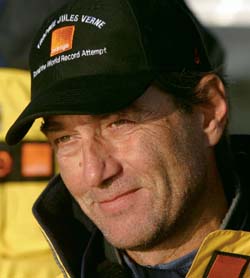
Bruno
Peyron
Last April, Fossett and his crew
of 12 sailed round the world in 58 days 9 hours 32
minutes, beating Peyron's previous record by almost six
days. This month, Fossett completed the first solo
nonstop flight around the world without refueling.
In 1993, Peyron became the
inaugural winner of the Jules Verne Trophy and the first
to sail around the world in less than 80 days.
A two-time holder of the
single-handed Atlantic crossing record, he was fortunate
last month when Orange 2 escaped undamaged from a
collision with a whale.
Ellen MacArthur, who in February
set a new mark for sailing solo around the world, failed
in an attempt to break the Jules Verne record in
February 2003 when her mast snapped into three pieces in
the Atlantic Ocean.
"Orange 2 was conceived to be
the quickest around the planet for the next five
years," Peyron said Monday as he approached the
line.
Peyron, from the French Atlantic
coast city of La Baule, has spent a lifetime perfecting
his racing skills.
The team crossed the line
off Ushant, France after 50 days, 16 hours and 20
minutes, lopping more than a week off American
Steve Fossett's 2004 mark. Peyron, who had 13 crew,
said: "We don't have any champagne, but we
don't need that to savour the moment." Ellen MacArthur's recent
solo mark was 71 days 14 hours on the trimaran
B&Q.
The Jules Verne Trophy is
based on the eponymous novellist's fictional tale
of Phileas Fogg's attempt to travel around the
world in under eighty days. The race was originally
conceived by French sailor Yves Le Cornec in 1985.
But it was not raced for
until 1993 when Peyron set the inaugural record of
79 days six hours on Commodore Explorer.
The 26,000-nautical mile
trip follows the old trade routes taken by the
early 20th century grain ships plying their trade
between London and Australia.
The route starts and
finishes between England's Lizard Point and Ushant
off France and goes past South Africa's Cape of
Good Hope, Australia's Cape Leeuwin and Cape Horn
off South America.
In the original record
attempt, three teams set off but Peyron's was the
only one to finish.
French skipper Olivier de
Kersauson (Charal) and the catamaran Enza of the
late New Zealander Sir Peter Blake - who was
killed by pirates in South America in 2001 - both
retired before the finish.
In 1994, Blake and
Britian's Sir Robin Knox-Johnston, the first man
to sail single-handed around the world non-stop,
advanced the record to 74 days 22 hours.
Three years later De
Kersauson returned to improve the record by three
days on the trimaran Sport Elec.
As technology moved on
and sailors became ever more adventurous, Peyron
instigated The Race, a non-stop no-rules lap of
the planet for elite, cutting-edge craft, to
celebrate the Millennium. The Race was won by Kiwi
Grant Dalton and his crew on the giant catamaran
Club Med in 62 days.
The time did not qualify
for the Jules Verne Trophy, though, as it began in
Barcelona and ended in Marseilles.
But it fired sailors'
imaginations and launched a renewed quest to break
the Jules Verne record.
Peyron himself took over
the catamaran Innovation Explorer, sailed into
second place in The Race by his brother Loick, and
renamed it Orange before surging into the record
books in May 2002 when he lapped the globe in 64
days. MacArthur attempted the
record in 2003 with a full crew on board
Kingfisher II but the bid was scuppered when the
giant catamaran was dismasted in the southern
Indian ocean.
LINKS
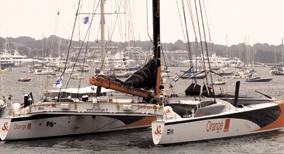
Orange
II, docked at Newport Shipyard
Jules
Verne Trophy 2005
Date: Saturday, January 29 @
02:53:34 EST
Orange
II are casting off this afternoon, meet the crew and
read more about skipper Bruno Peyron...
The 14 men taking part in this new attempt at the Round
the World sailing record (Jules Verne Trophy 2005), on
board Orange II are : Bruno Peyron (Skipper), Roger
Nilson (navigator, doctor), Lionel Lemonchois (watch
leader - helmsman), Philippe Péché (watch leader -
helmsman), Yann Elies (watch leader - helmsman), Ronan
Le Goff (Bowman, in charge of rigging), Sébastien
Audigane (helmsman, in charge of safety), Jacques Caraes
(adjustor, in charge of filming), Florent Chastel
(bowman, in charge of running rigging), Yves Le Blévec
(adjuster, in charge of the general organisation), Jean-Baptiste
Epron (adjuster, in charge of supplies and logistics),
Nicolas de Castro (Bowman, in charge of composites),
Ludovic Aglaor (helmsman) and Bernard Stamm (helmsman,
in charge of mechanics).
Bruno Peyron
Pioneer of ocean multihull racing since the early
80’s, Bruno Peyron has taken part in almost all of the
major sailing events, both single-handed events and with
a crew. He has 37 Atlantic crossings under his belt, 12
of which were single-handed.
Twice record holder of the single-handed crossing (1987
& 1992).
Twice record holder of the Pacific crossing with a crew
(1997 & 1998), one major victory sums up his racing
career: he was in 1993, the first sailor to go around
the world in less than 80 days, thus winning the first
Jules Verne Trophy.
He created The Race, which began at the end of 2000,
then repeated his exploit around the world in 2002,
becoming the holder of the Jules Verne Trophy for a
second time.
Bruno Peyron is today the record holder of the greatest
number of miles covered in a maxi-catamaran (295,000
miles). He has beaten the 24 hour record on four
occasions (1982 / 1995 / 2000/ 2004).
He is the only skipper to have covered more than 700
miles in 24 h, and since last summer, has been the
holder of the Mediterranean crossing record.
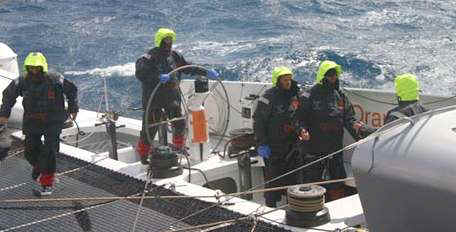
De quart dans les
40es hurlants
Jules
Verne Trophy : Peyron rounds cape Horn in 32 days 13 h
and 29 minutes and adds new records
Saturday February 26th, 2005
Saturday
26 February : Bruno Peyron and the crew of the giant
catamaran Orange II crossed the longitude of Cape Horn
tonight at 23.32 GMT, after 32 days 13 h and 29 minutes
of racing. Having set out from Ushant on 24th January,
Orange II has set a new record time for the crossing of
the South Pacific in 10 days 23 hours 35 minutes (Cape
Leeuwin - Cape Horn) and is making her way into the
Atlantic Ocean 7 days 2 hours and 47 minutes ahead of
the crewed round the world record time set by the
American Steve Fossett last winter.
The
intermediary times to the Horn are amazing. Orange will
have taken 18 days and 8 hours since the Cape of Good
Hope, or three days better than the previous record for
this stretch held by Innovation Explorer since The Race.
They have also set a new record for the stretch between
Cape Leeuwin and Cape Horn in 10 days and 23 hours, or
two days better than the previous record set by Bruno
Peyron himself on Orange I during the Jules Verne Trophy
2002.
The
main journey times to Cape Horn
Ushant
- The Horn New record: Orange II, Bruno Peyron, 2004: 32
days, 13 hours and 29 mins Former record: Cheyenne,
Steve Fossett, 2004: 39 days, 16 hours and 16 mins (+7d,
2h,47’)
Good
Hope - Cape Horn New record: Orange II, Bruno Peyron,
2004: 18 days, 8 hrs and 8 mins Former record:
Innovation Explorer, Loïc Peyron, 2001: 21 days, 7 hrs
and 5 mins
Leeuwin
- Cape Horn New record: Orange II, Bruno Peyron, 2004:
10 days, 23 hrs and 35 mins Former record: Orange I,
Bruno Peyron, 2002: 12 days, 19 hours and 30 mins
Tasmania
- Cape Horn (WSSRC Pacific Ocean record) New record:
Orange II, Bruno Peyron, 2004: 8 days, 18 hours and 6
mins Former record: Cheyenne, Steve Fossett, 2004: 11
days, 20 hours and 18 mins
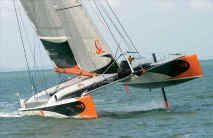
February
15 : Three new records for Orange II to Cape Leeuwin
The
cape Leeuwin (south-western tip of Australia) has been
rounded last night at 23:58’ GMT by the Orange II maxi
cat. Bruno Peyron and his men left Ouessant on January
24 at 10:03 GMT, and only took 21 days and 14 hours to
reach the second landmark of their RTW journey. Three
new records have been captured when the giant crossed
the longitude of Leeuwin (115°08E): Good Hope - Leeuwin
previously held by Loïck Peyron aboard Innovation
Explorer (new record by Orange: 7 days, 5 hours, 35
minutes).
Orange II also bettered Cheyenne’s time on
the Ouessant - Leeuwin portion, taking 4 days and 14
minutes off the previous record! Finally, Peyron and
crew beat the Equator - Leeuwin performance set by the
Geronimo trimaran, doing more than 5 days better with a
new record of 14 days and 11 hours. Last figure: by
getting to Australia after 21 days, 13 hours and 54
minutes at sea, Bruno Peyron and his crew have signed an
average speed of 22,8 knots since their start, which
amounts to a 15% gain compared to Cheyenne’s time.
But
for the moment, conditions are tough under Australia,
and Bruno Peyron had to ease off a bit, and take the
gennaker down: first of all for basic safety reasons,
since Orange was doing 30 to 35 knots of speed in 6 to
8-metre waves, and secondly because there’s no
interest in catching up with a front generating 40 to 45
knots of wind...
Bruno
Peyron: “We had not been so successful on the Indian
Ocean in the past, in 1993 during the first Jules Verne
ever, or in 2002 with Orange I... This year it’s
radically different, and I think it’s a good sign. Yet
it does not impress us that much - true, it only took us
7 days between Good Hope and Leeuwin, but the boat can
swallow that portion even faster, I’d say in 6 days.
What matters more is the fact that we sustained a
satisfactory average speed while following a route full
of zigzags. For the moment, all things considered
everything, it’s not been so bad!”
New
records
•
Ushant - Leeuwin
New record: 21 d 13 h 54 mn: Orange II -
Bruno Peyron - 2005
Previous record: 25 d 14 h 08 mn - Cheyenne
2004
•
Equator - Leuuwin
New record: 14 d 11 h: Orange II - Bruno
Peyron - 2005
Previous record: 19 d 17 h 27 mn -
Geronimo 2003
•
Good Hope - Leeuwin
New record: 7 d 05 h 35 mn: Orange II -
Bruno Peyron - 2005
Previous record: 7 d 14 h 30 mn 5 sec:
Innovation Explorer - 2001
The
records Orange II has to beat
The Jules Verne Trophy, held since 29th
April 2004, by Olivier de Kersauson and the crew of the
trimaran Geronimo, in 63d, 13h 59mn.
The absolute round the world record held
since 5th April 2004, by the American Steve Fossett, in
58d, 09h, 32mn.
Orange
II’s most recent records
The world 24 h record (706.2 miles covered
at an average speed of 29.42 knots),
The Mediterranean Record (17h 56mn and 13s,
at an average of 25.53 knots),
The record between Ouessant and the Cape of
Good Hope (14 days, 8h and 19mn),
The record between the Equator and the Cape
of Good Hope (7 days, 5h and 22 mn).
Friday
11th : Bruno Peyron’s maxi-catamaran is heading due
east towards the Kerguelen Islands
After
just 18 days of racing, Bruno Peyron’s Orange II
maxi-catamaran is accelerating again and heading due
east towards the Kerguelen Islands, which they should
pass on the northern side during the night. Sailing at
an average speed of almost 25 knots since early this
afternoon, the giant Orange II is currently feeling the
first effects of the low-pressure area they were
expecting, which should generate north westerly winds
taking them all the way to Cape Leeuwin (Australia). In
spite of easing off a little yesterday, which allowed
the crew to carry out a check-up of the boat, they are
still more than 3 days ahead of Cheyenne and Géronimo‚s
times and have been keeping up the average speed since
the start to 22.3 knots.
During
today’s radio session, the skipper of Orange II, who
had just rewarded himself with two hours of sleep under
the duvet, talked about the conditions they were
experiencing in the deep south and about his strategy
for the next few days. Bruno Peyron: «We‚re starting
to pick up the north westerlies that we had been waiting
for, and that should allow us to pick up some speed over
the next few hours. In fact, we were forced to slow down
because of the ridge of high-pressure, which was not
moving fast enough and that we reached each time we
stepped up the speed. That seems to have sorted itself
out now, as we‚re beginning to feel the first effects
of the front of this low-pressure area, which I‚m
hoping will take us all the way to Australia.»
Extracts from
today’s radio session with Bruno Peyron and Bernard
Stamm
Pit
Stop: «During our pit stop, yesterday, the crew of
Orange II carried out a complete check-up on the boat.
The mast, rigging, inside the hull, pulleys, travellers
and mainsail head were all given the once over. We
changed the fittings on the mainsail head, which were
starting to wear. Apart from that, the boat seems in
perfect condition.»
Progress:
«I never stop thinking about it, as it‚s the only
thing that keeps me going. Knowing how we can do better
tomorrow. Imagining that the progress could one day come
to an end is not very pleasing from an intellectual
standpoint. I‚m convinced that technological progress,
time and the knowledge acquired by man can only move
forward.»
The
storms: «We could always find ourselves facing a huge
storm, like in 1993, as the seas and winds are still as
powerful in the deep south. However, a lot has changed
over the past ten years. Firstly, there has been
enormous progress in weather forecasting, and the charts
are more accurate than at that time. The first big storm
(75-knot winds and 15-metre troughs) that we experienced
in the Jules Verne Trophy in 1993 was down to a mistake
I made. What we know today about the weather conditions
allows us to understand better the various weather
patterns and anticipate them. We are sailing today
aboard bigger boats, which are better able to face up to
the strength of the waves. Finally, we have learnt to
sail in these extreme conditions and we feel safer on
these giant cats.»
The
Jules Verne Trophy: «The historical aspect of the Jules
Verne Trophy is down to its timeless quality. I was
lucky to be the first to grab it in 93, then for a
second time in 2002. Today, the men on board are less
attentive to labels and pay more attention to what they
are doing and to sheer performance.»
Alain
Prost : «It is not out of the question that we could
one day sail together. We already talked about it in
Marseilles. Alain is a fan of speed, technology and
performance and while he hasn‚t yet mastered all the
skills required, I‚m quite sure he could learn very
quickly. In any case, he could adapt to our sport more
quickly than I could to his.»
Bernard
Stamm. The 60 foot Open skipper talked at the start of
the radio session: «I’m highly impressed by this wind
machine. You get used to sailing at high speed very
quickly. The boat is a marvel to steer. It’s a bit
like a sporting cat. At 30 knots aboard my monohull,
it‚s really a battle, while on board Orange II, you
really feel perfectly safe. Bruno gave me a great
opportunity by allowing me to take part in this
adventure. He’s a real leader of men, and everything
is going very smoothly on board.»
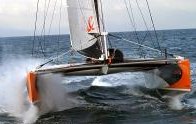
Wednesday
9th February 2005: Bruno Peyron’s crew had covered 8643
miles since the start
The
giant Orange II is likely to give up a few miles to her
virtual opponents today, because of the westerly flow
they are in, which is forcing them to tack between 45°
and 50° South. After passing the Prince Edward Islands
early this morning, the boat is continuing to cross the
Indian Ocean heading towards the Kerguelens, squeezed
between the light winds in the north and icebergs
further south. In spite of this, her average speed over
24 hours is still close to 20 knots. At 10.00 GMT this
morning, at the end of the sixteenth day of racing,
Bruno Peyron’s crew had covered 8643 miles since the
start, and increased the lead over the round the world
record time (+ 1860 miles ahead of Steve Fossett’s
record time).
The
skipper of Orange II talked about life on board during
this awesome crossing of the hostile Indian Ocean. In
particular, he announced that the boat’s radar had
broken down, and that this was a real problem now that
they were on iceberg alert.
Here
are some extracts from the radio session with the
skipper of Orange II :
The
weather and radar no longer functioning: The weather is
magnificent, and certainly does not reflect the tension
of the last few days, as we’ve been used to sailing in
grey conditions in these latitudes. We’re in a
mousetrap, blocked by calms and ice. A high-pressure
ridge is arriving from the north. We adopted a rather
conservative strategy concerning the icebergs. While
there is ice to our south, we only head back down during
daylight hours. We can tell you now. We no longer have
any radar. There’s no way we’re going to play
Russian roulette. We gybed, when we saw the fifth
iceberg. At night, we head back up. An iceberg is
beautiful to see. It’s nice to see them when you’re
in an exploration ship, but not aboard a carbon monster
travelling at 30 knots. I can understand why people are
fascinated by this beauty, but it’s better for us to
get away from there. We’re not really welcome here.
Icebergs : our trajectory took us down on
the closest curve possible to the direct route. We gybed
3-4 hours earlier than planned. Just as well, as we
would have found ourselves on the other side of the
"mine-field." The sea temperature has fallen
to 5°. We saw during the Vendée Globe that there can
be some further north. We must remain cautious, sensible
and act responsibly, as we’re always tempted to take
the shortest route. If we have to lose a dozen or twenty
hours for safety reasons, I’ll accept that.. How to
spot the icebergs : they can be seen with the naked eye
during the day, when there is decent visibility (this
morning, we couldn’t even see the bow of the boat!) or
with the help of electronic devices. We have a third way
of spotting them : infrared binoculars. We put a man on
watch at the bow. As the radar is no longer working,
we’re down to this watch, like in the old days.
The lead over Cheyenne and Geronimo : we
know our lead precisely. We have a lead of just under
four days over Fossett. Over the past day, he won back a
few miles. Our aim is to get out of this tricky area to
the Kerguelens with between three and three and a half
days lead with a boat and crew in fine fettle. The
weather ahead should enable us to benefit from a north
westerly flow to go on the attack! Remaining sensible:
It doesn’t bother me to ease off on the speed, when we
need to, in order to put on more speed later, when
conditions allow. You need to keep your wits about you
to take the necessary decisions. The difficulty is when
you drop behind and you don’t have the intellectual
faculty to take the right decisions.
Log: We use a computer on the navigation
table. Roger Nilson, as our navigator, notes everything
down. That’s not a legal requirement, but for our own
use. It’s a way of remembering everything that
happened on board. There are things you tend to forget
over such a long journey. When we re-read it later, we
realise there are things that we didn’t pay enough
attention to at the time. Roger is very technical. He
writes a more factual log. I’ve got an exercise book
in which I note down other information.
Ellen MacArthur : We keenly followed the
Vendée Globe and her record. It’s only half a
surprise, as it’s not the first time she has done
something amazing. Rest: The last ten minutes have been
the first time that we’ve had such sea conditions and
are making less than 25-30 knots. We hadn’t seen that
since coming out of the Doldrums. I hope that will
remove some of the stress from the minds of the crew.
For the moment, the boat is in perfect condition. We
check her over at the end of each watch, or in other
words every 4 hours. We’re going to take advantage of
this calm zone to stop. We’re going to lower the sails
and send the bowman up the mast to check everything
over.
Icebergs and the strategy ahead: We’re
really frightened of icebergs. We know they are not far
off. We hoped we had a wide enough margin to avoid them,
but there they are. We’re in a tricky situation with
the ice and the calms. That means we shall be losing
some time, but not over the record. The wind is easing
off sooner than forecast. That means we should be able
to head off to the right, but we can’t, because it’s
dark.
Performance: We’re the first to be
surprised by our performance. We did what we could. The
crew have worked like mad since the start. We were on
the attack until yesterday. Since yesterday morning,
we’ve adopted a more conservative approach. That will
last for two days. Our next attack will be with the next
front. Playing with the weather: In 93 during the first
Jules Verne, we were the first boat to play yo-yo with
the weather systems in the deep south. Last summer, we
left behind one system, caught a low, got through it and
reached England before the winds. If we had left later
from New York, we would have arrived with the winds.
Orange II is a time machine. It’s amazing!
Peter Blake : During the first Jules Verne,
the people I thought about were those, who preceded us
in the 19th Century at the time of the clippers. During
the Cape Horn storm in 1993, we complained about the
cold, but we forgot what it was like there 100 or 150
years earlier. This Jules Verne story, I shared it with
Peter Blake. He is no longer there, and from time to
time, we tip our hats to him. There are times, when we
would have liked him to be at our side in the same boat
going along at 35 knots.
Day
at sea: 16th
Date
: 09/02/2005
Time
(GMT) : 10h00
Latitude
: 48 09.08’ S
Longitude : 40 39.40’ E
Speed
over 24 h: 20.7 knots
Distance over 24h : 497 miles
Speed since the start : 22.5 knots
Total
distance : 8643 miles
Remaining distance : 16339.50 miles
Lead on day 16:
J. Verne record: +1680 miles (ahead)
absolute record: +1860 miles (ahead)
The
records Orange II has to beat
The Jules Verne Trophy, held since 29th
April 2004, by Olivier de Kersauson and the crew of the
trimaran Geronimo, in 63d, 13h 59mn.
The absolute round the world record held
since 5th April 2004, by the American Steve Fossett, in
58d, 09h, 32mn.
Orange
II’s most recent records
The world 24 h record (706.2 miles covered
at an average speed of 29.42 knots),
The Mediterranean Record (17h 56mn and 13s,
at an average of 25.53 knots).
TROPHEE
JULES VERNE 2004 :
Orange II est
arrivé à Lorient
Le
22/02/2004
Le
maxi-catamaran ORANGE II de Bruno Peyron est arrivé ce
matin à 9h30 à Lorient, après un convoyage retour
d'un peu plus de trois jours.
A peine mis à quai devant la base du Défi Français,
l'équipe à terre du bateau a pris en mains les opérations
de démâtage, de grutage et de mise au sec du bateau.
Un chantier a été improvisé sur place grâce à des
échafaudages protégeant les parties avant des coques
avant. Depuis hier déjà , les deux crash box du bateau
(extrémité de l'étrave devant servir de pare-choc
avant), ont été reconstruites au chantier Multiplast
et acheminées sur place.
TROIS
JOURS DE RÉPARATION
Comme
annoncé avant-hier, la réparation du bateau devrait
prendre 3 jours. Dès ce soir, les deux crash box (pièces
réalisées en mousse à faible densité) devraient être
recollées, avant d'être shapées et stratifiées
demain lundi, puis enduites et peintes mardi. Les
architectes du bateau, Gilles Ollier et Yann Penfornis :
"Nous allons changer les crash box des deux
coques. Les deux pièces sont déjà terminées. Elles
ont été faites dans une mousse un peu plus dense.
Elles auront donc un peu moins de capacité
d'amortissement en cas de choc, mais elles seront également
moins sensibles... ".
PRÊT
POUR UN NOUVEAU DEPART
Côté
météo, on s'active déjà à bord d'Orange II pour étudier
l'éventualité d'une prochaine fenêtre météo. Bruno
Peyron : "Nous mettons tout en oeuvre pour être
prêts à repartir le plus rapidement possible.
Apparemment une fenêtre météo pourrait nous être
favorable le 26. La course contre la montre est lancée
".
NEWPORT
- There may have been a record-setting vessel docked in
the Newport Shipyard this week. But we won't know for
sure for about four days.
The maxi-catamaran Orange II, and French skipper Bruno
Peyron, left Newport early Thursday evening for New
York. Once there, the boat will set sail across the
Atlantic toward Lizard Point in Great Britain.
If
all goes well, the 36.8-meter Orange II will reach its
destination in 4 days, 17 hours, 28 minutes and 6
seconds or less. That is the world record, set in 2001
by PlayStation and skipper Steve Fossett.
Also in Peyron's sights is a shot at the 24-hours
record. In 2002, Brian Thompson and Maiden 2 sailed
694.78 miles in 24 hours.
"We have a target with this operation that is very
clear," Peyron said Thursday in Newport Shipyard.
"One, we want to try and push the boat as much as
we can in order to be at the right level at the end of
the year.
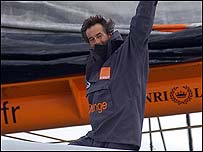
Bruno
Peyron waves to onlookers
"Two, is to try to achieve the best world
performance of the year on this course. Three, to try to
break the 24-hours record ... which is very fast,"
Peyron added, "and finally, the last goal, of
course, is to be in a position to give us hope (to
break) the absolute record."
The original North Atlantic record was set in 1904 by
Charlie Barr. His record of 12 days, four hours lasted
75 years and has since been broken by only six boats
with crew and four single-handed boats.
Peyron was the first one to break the record
single-handed in 1987 but lost the record in 1990, only
to regain it in 1992. He also set a crew record in 1997
that PlayStation broke in 2001.
Now, Peyron wants to take back that record.
"Orange II is probably the fastest boat in the
world now," he said. "But it's brand new, so
we have to improve and slowly progress throughout the
course in order to break our main target."
While Peyron would certainly not mind breaking the North
Atlantic record this time around, it is, according to
therace.org, only the second-most prestigious sailing
record.
The "main target" is the Jules Verne Trophy.
Peyron first won the Jules Verne Trophy in 1993 after
navigating the around-the-world course in 79 days. In
2002, he set a new record of 64 days with Orange II's
predecessor, Orange.
The North Atlantic race serves Peyron and Orange II as a
tune-up for the Jules Verne Trophy in the winter.
"We have to push the boat as much as possible in
order to be the fastest boat in winter, for the
around-the-world," Peyron said.
By Thursday afternoon, preparation of Orange II was
nearly complete. The official starting line for the
North Atlantic course is in New York, but Peyron said he
preferred to keep the catamaran in Newport before the
start.
"We have technical needs, which is a lot easier to
find here in Newport than in New York. Especially here
in Newport Shipyard," he said. "This yard is
just perfect to prepare a boat like (Orange II). They
understand exactly what is needed for a cruising boat or
a racing boat.
"Even a special racing boat, like a big, giant cat,
you can find everything you need. It's very well
organized."
Organization is one of many things that Peyron needs to
go his way for that big, giant cat to reach Lizard Point
in less than four days and 17 hours. But, if the weather
and the boat cooperate, Orange II could hold two records
by the end of next week.
 17-03-05
: Orange 2 largue les amarres pour
Lorient 17-03-05
: Orange 2 largue les amarres pour
Lorient
 17-03-05
: Pieds à terre 17-03-05
: Pieds à terre
 16-03-05
: Un chantier derrière le record 16-03-05
: Un chantier derrière le record
 16-03-05
: Concert de salutations 16-03-05
: Concert de salutations
 16-03-05
: 50 jours, 16 heures, 20 minutes
et 4 secondes 16-03-05
: 50 jours, 16 heures, 20 minutes
et 4 secondes
|